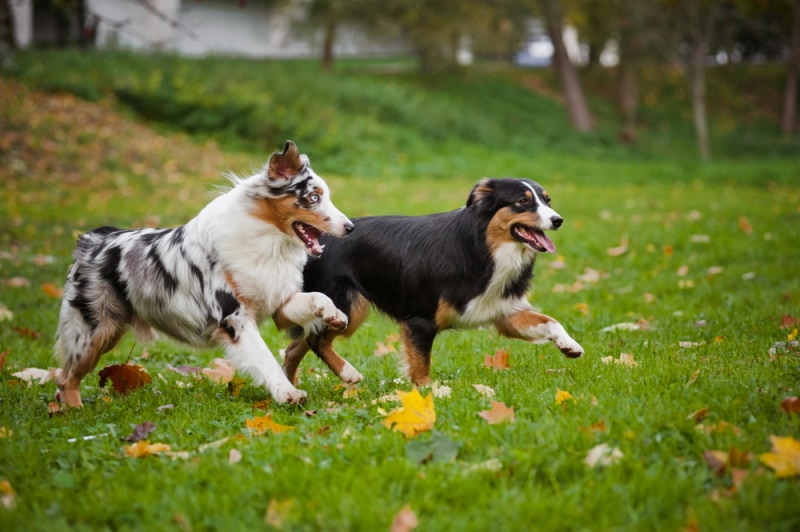
Click Below to Skip Ahead
Border terriers are small dogs that usually stand a little taller than 12-inches at the shoulder. It has a uniquely shaped head that gives it an otter-like appearance. It usually has a short but wiry coat available in several colors and a strong, agile body.
Breed Overview
Height:
11 – 16 inches
Weight:
11 – 14 pounds
Lifespan:
12 – 15 years
Colors:
Red, blue, wheaten, black, black and tan
Suitable for:
Families, apartments, allergy sufferers
Temperament:
Affectionate, alert, even-tempered
The fur is weatherproof and repels dirt, so it stays relatively clean and only requires moderate grooming. Border Terriers are hard workers that enjoy spending time with the family and will usually stay close by when you are home.
Border Terrier Characteristics
Border Terrier Puppies

Border Terriers make wonderful family dogs and you will love them if you suffer from allergies, as they don’t shed as much as other breeds. They get along well with children and other pets, though this can depend on how early they are introduced so if you adopt an older dog, some training may be required.

Temperament & Intelligence of the Border Terrier
The Border Terrier is a loving and playful breed that makes them a great dog for families and the single owner. It’s adaptable and can learn to live in a small apartment. It’s extremely intelligent and learns new tricks quickly, but it can also be quite stubborn and difficult to train for someone without experience and plenty of patience. It’s also clever and can figure out how to open gates, doors and get around other things meant to stop it. It also likes to bark, so you will need to start early with training to keep it from getting out of hand. However, the barking helps them be great watchdogs, and you will always know when something strange is going on in your yard. Its fearless behavior will protect you regardless of the danger to its own life but can make it difficult to walk the dog where other dogs go.
Are These Dogs Good for Families? 👪
The Border Terrier is a loving and playful dog with plenty of energy for chasing after balls, playing fetch, and running around the yard. It loves to be around children, and they will help it get the exercise it needs. It loves big yards but is adaptable to smaller homes as well. It’s protective and will keep your family safe from intruders. It likes to explore on its own, so it won’t mind as much as many other breeds if you have a long day at work.
Does This Breed Get Along with Other Pets?
If you start socializing your Border Terrier with other pets, it will likely grow to enjoy their company and even begin to protect them. However, it often sees other dogs as threats, and cats can activate its instinct to hunt. It can also be difficult to bring new animals into the house to replace ones that pass on.
Things to Know When Owning a Border Terrier:
Food & Diet Requirements 🦴
Border Terriers are extremely active dogs, so they will require food with plenty of protein. Most brands that have chicken, turkey, or other real meat listed as the first ingredient should work perfectly. Avoid foods with meat byproduct listed above real meat, chemical preservatives, and artificial colors. Some brands will also contain omega fats that can help produce a shiny coat and reduce inflammation. Probiotics can help balance the digestive system and reduce the frequency of diarrhea and constipation while boosting the immune system. We highly recommend following the portion guidelines listed on whatever food you choose to reduce your dog’s risk of becoming overweight.
Exercise 🐕
Your Border Terrier will require plenty of exercise to stay happy and healthy. It’s one of the most active breeds, and we recommend setting more than one hour aside each day to help your dog stay fit. As we mentioned earlier, this breed enjoys chasing balls and will do it all day long if you keep throwing it, especially when they are still young. Long walks can help if you can find an area where there aren’t a lot of other dogs that might cause your dog to get aggressive.
Training 🎾
It can be difficult to train your border terrier because they can be stubborn and can lose focus if they detect an intruder in the yard. We recommend setting up training sessions at the same time each night to get your dog into a routine. Starting these sessions early in life will help your dog get used to learning, and they might come to enjoy it.
Keep plenty of treats ready as you repeat a command and motion what you want your dog to do. If your dog follows your command, give it a treat and try again. It can take several attempts before your dog commits it to memory and obeys on the first or second try. We recommend keeping the sessions short. Five or ten minutes per day should be more than enough to try out a few commands before your dog loses focus. A positive attitude, patience, and consistency are the most important part of your training program.
Grooming ✂️
The Border Terrier has a double coat that helps it thrive in cold weather. It’s not a heavy shedder but will shed the coat in spring and fall and can leave quite a bit of hair around your home if you don’t frequently brush it at this time to collect the fur. During the offseason, you should only need to brush the coat once or twice per week. We highly recommend brushing the dog’s teeth with a safe pet toothpaste to help slow the progression of dental disease, which affects many dogs. If your dog is an apartment dweller, you may also need to trim the nails if you hear them clicking on the floor.
- You might also be interested in: 11 Best Dog Shampoos: Reviews & Top Picks
Health and Conditions 🏥
- Hip Dysplasia
- Progressive Retinal Atrophy
- Allergies
Minor Conditions
Serious Conditions
Male vs Female
Male Border terriers tend to be slightly larger than females, but there are no differences in temperament or intelligence.
3 Little-Known Facts About the Border Terrier
1. Border Terriers needed to feed themselves in the 1800s, so they are highly skilled hunters.
2. The first Border Terrier was registered in America in 1930.
3. Originally, only Border Terriers that could bolt a fox had value.
Final Thoughts
The Border Terrier is a great family best, but it is better suited to an experienced user who can train it and properly socialize the dog so it behaves and can cohabitate with other animals. It makes a great watchdog and s friendly, loyal, and protective of family members. It doesn’t require a lot of maintenance, but you will need to put up with a considerable amount of barking. We hope you have enjoyed reading over this review and have learned some new facts. If we have convinced you to give one of these dogs a try, please share this guide to the Border Terrier on Facebook and Twitter.
Find out more about other popular dog breeds:
Featured Image Credit: Colin Seddon, Shutterstock








